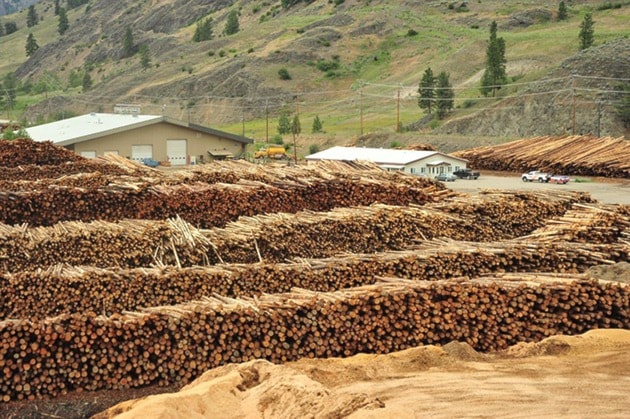
Joe Boltz worked with the old Pope & Talbot mill in Midway for 27 years before it went out of business. Having grown up in Greenwood, he’s seen first hand the boom and bust of the mill in the community. As the newest incarnation of the mill, Vaagen Fibre Canada, comes up on its five year anniversary in Midway, he said the mill really made a difference in a community that was set to decline.
“[The mill closing] turned everything into a ghost town. It shut down not just the mill, but the loggers, everything,” Boltz said. “The only thing that went on when the mill was shut down is the government had projects … otherwise it was pretty quite when the lumber industry went for a downswing.”
It’s due in large part to the opening of the Vaagen mill and the jobs it brought back that Midway is still the community it is.
The company, owned by the Vaagen family, is a branch of the mill based in Colville, Washington. Vaagen bought the mill in 2011 after Pope & Talbot, the previous owners, went bankrupt and shut the doors in 2007. Pope & Talbot employed an estimated 200 people when it closed. In a town that had a population of just over 600 at the time, it had a huge impact.
Duane Vaagen, CEO of Vaagen Brothers, said the company decided to move into the near-abandoned Midway plant because of the ready-made markets in the area, and its proximity to their home operation. Over time, Vaagen said, the mill has worked to build relationships with the community.
“What is good for us is good for the community and vice versa,” he said. “We don’t have anywhere else to go, we live close by. This isn’t about shareholders in Toronto and New York. This is about Midway, Greenwood, Rock Creek, Grand Forks. It’s all local and stays local.”
Over the past five years, the mill has grown and changed a lot. As with any start-up, there are always a few hiccups, Vaagen said.
“There was a lot. The first two years were real painful, the third year was kind of painful, then it turned the corner, now it’s not painful. The progress is paying off today, [but] there is a lot of work to do. There’s another two years to be where we want to be,” Vaagen said.
The mill has seen a lot of growth—over time, the number of people employed has grown from 50-odd to 85 on the last payroll. More than that, there are indirect jobs. In logging, the Vaagens estimate four indirect jobs for every one person employed at the mill.
But one of the difficult things about milling is the dependence on the environent. Last summer’s Rock Creek fire could have easily spelled disaster for the company, but it found the upside: processing burned wood, normally seen as highly undesirable because of how difficult it is to work with.
“Those owners were left with hundreds of acres of burnt, dead trees,” said Curtis Vaagen, Duane’s son.
Vaagen said he attributes the increase in workers in part due to the volume of burnt wood from the Rock Creek fire.
“We added volume and it opened the doors,” he said. “It is not easy for the loggers or the workers, it is very tough on the community … but how can we make that a little bit better? How can we recover?”
And there’s no sign that it will slow down anytime soon. Dan Mcmaster, the fibre manager for the mill, points to a few areas that will soon be cleared to house more logs. Mcmaster is responsible for purchasing the logs that come into the yard. Seeing the yard full of logs is a good indicator that the mill is doing well, he said.
“A year and a few months ago, there were no logs in this place. You could shoot a cannon through here, it was so frustrating,” Mcmaster said. “Now, we’re so full. We probably have three months of logs to run this place.”
Scott McLaren, a kiln operator with the mill, grew up in Grand Forks and has been working with Vaagen for almost five years now.
“We see young people walking around Midway again, whereas before it was a lot of seniors. You can go out and see people with strollers … you never saw that before,” McLaren said. “It was becoming a retirement community.”
“I grew up here, my dad was a superintendent here,” he said. “Once you see people start to buy new vehicles or houses, you know they are starting to feel that this is going to be their life. That’s a big investment, and you know you’re not going to do it unless you have 25, 30 years of employment.”
Right now, the mill is focused on the present and continuing to improve. But reflecting on five years and what the future might bring, Vaagen said he’d like to see the mill and the company continue to grow.
“When you’re as old as I am you just see yourself 10 years older and trying to figure out what that’s going to look like,” Vaagen said. “This should be running effectively and efficiently, a well-run machine, with these young people being trained, and running a very smooth operation.”
